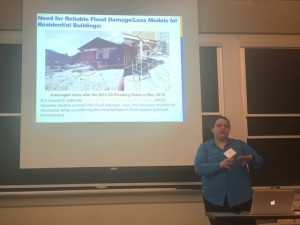Dr. Deniz has recently attended the ASCE Engineering Mechanics Institute Conference (EMI), held at Michigan Institute Technology (MIT), to present about “Empirical and Analytical Assessment Models for Flood Damage and Loss on the Residential Building Structures”.
ABSTRACT:
Reliable and accurate estimates of losses to civil infrastructures and community due to extreme hazards of uncertain magnitude have recently become imperative in efforts to measure the resilience of communities. While collapse or major damage mitigation is an essential objective in promoting hazard-resilient construction, non-structural damage to building components (e.g., non-load bearing walls, windows and facades) as well as to building contents (e.g., machinery and equipment) can also cause significant economic losses and can disrupt the functionality of buildings. Therefore, it has become essential to develop reliable and accurate loss assessment approaches that include the effects of both structural and nonstructural damage to the built environment due to extreme hazards.
This paper describes the potential direct physical impacts of flood events on residential structures using the 2013 Boulder, Colorado flood case study. Using the Boulder case study, two models are presented in this paper to assess both structural and nonstructural flood damage and loss for residential structures, considering variabilities in building and damage characteristics. The first “empirical” model uses empirical data collected from building damage inspections after the flooding event and probabilistically predicts the economical losses as a function of key building and hazard parameters. The second“analytical” model uses an assembly-based approach to predict the economical losses based upon the repair cost of unit prices for each damaged component in a typical residential building, considering construction and material costs in the site of interest. These two models provide a unique opportunity to compare different methods to flood loss modeling in a US context. While the models are developed for a specific case study, the models can be utilized as a predictive tool in the future to assess the potential flood losses for a set of residential buildings in any US community.

